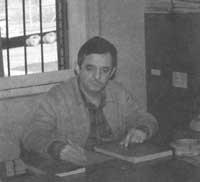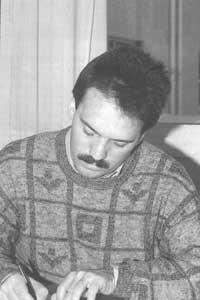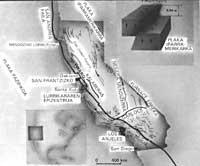Concrete Evil
1989/02/01 Jauregi, Mariaje - Elhuyar Fundazioa Iturria: Elhuyar aldizkaria
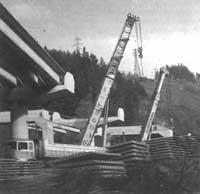
With the creation of concrete in the second decade of this century begins a revolutionary stage for the construction sector. The large public works made with this material were announced a life span of more than one hundred years. But recently there has been the so-called reinforced concrete cancer, a disease that slowly runs the inner concrete steel. This concrete, moreover, is responsible for maintaining these large structures and reduces the lifespan of bridges, dams, dikes and highways to the half of the time that was projected in its construction.
The origin of this deterioration is double: on the one hand, the salt that is poured to avoid the ice that forms on bridges and highways during the winter is mixed with water and introduced into the microscopic pores of the concrete. When it reaches the steel structure that supports it it begins to oxidize, and sometimes the aggression is so hard that the formed oxide makes the metal a volume almost thirty times larger.
On the other hand, in industrial societies pollutants from streams, such as carbon oxides (IV), can also enter the material and damage the steel rods until they run.
The visible signs of this disease are dark spots that appear on affected bridges or levees. At the same time, the progressive state of deterioration, in addition to losing the aesthetic appearance of the work, severely reduces its mechanical resistance at the time of its construction.
This is the case of the dome of the Berlin sports palace. The dome fell and it is not known for sure why it occurred, but it seems that the concrete used was in poor condition.
According to experts, reinforced concrete constructions in northern and middle European countries with cold weather and lots of snow are very affected. Reinforced concrete cancer has already attacked more than half of the bridges in Switzerland and Italy and, despite costly repair techniques, it seems that they will not last more than twenty years. All of this has led governments in countries such as Europe and Canada, Japan and the United States to deepen research into the process, develop new technologies to repair damage and find ways to extend the lives of bridges and highways affected by this disease.
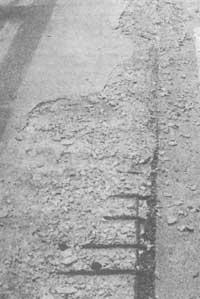
Although in the Spanish state the climate is not so demanding, there are numerous sections of highway and bridges attacked by this corrosive disease.
This disease can crush large structures.
How to diagnose corrosion
Metal reinforcement corrosion experts have developed a technology that allows to know the internal state of the affected works in a few minutes. On the exterior surface of the building an electric signal of ten billion watts is applied. This generates a new response signal in the structure being analyzed, which is processed on the computer. The application of this technique in the work itself allows a real-time corrosion diagnosis, checking the speed with which it is produced and consulting the repair. It is also able to become aware of the state of health of large buildings and recommend the repair of the affected works. What at the moment cannot be done is to eliminate the effect of pollutants that undo iron.
The buildings most affected by this disease in Spain are the highways of Barcelona, Valencia and Gijón. Also some buildings near the sea, due to sodium chloride. In many cases, the physical deterioration of these buildings is almost noticeable.
Nowadays, however, concrete is irreplaceable in construction, since it is cheap and offers great possibilities. Therefore, the technological fight against the disease should be a priority in countries where there is a heritage built with this product, but without forgetting the reduction of the accumulation of pollutants caused by industrialization.
Faced with the problem of concrete, we addressed the head of the Road Laboratory of the Provincial Council of Gipuzkoa, in order to have more news. Here is the interview with Pedro Fernández Garmendia. Elh. : What can you say about the history of concrete? P.F.G. : Elements similar to concrete have long been used. The Romans used clusters of detailed additions mixed with binder. On other occasions, whitewashed clay has been used or mixed with gravel of different sizes to make walls and constructions. What we know today as concrete began to be used in the second half of the last century. From there a lot of concrete has spread. Elh. : Could you briefly explain the characteristics of concrete?
P.F.G. : Concrete is very good for working in compression, but very bad for working in traction. In this case the resistance is the tenth of the first. Given that in almost any construction forces of traction or compression appeared, something had to be added to the concrete to be able to work to the traction. This appendix was steel in bar and was born of reinforced concrete with the concrete-steel pair. Therefore, in reinforced concrete structures concrete will work in compression and steel bars will work against tensile forces. Elh. : What can affect concrete? P.F.G. : Concrete can suffer two types of attack: chemical attack and physical attack. In case of chemical aggression, it can be affected by the concrete surface or by the inner armor. When it occurs on the surface, usually there are no problems, since in a dimension of 30 cm. wide, a centimeter of surface deteriorates too much. But this depends on the nature of the concrete anejo. On the contrary, if the concrete has cracks or cracks, the external aggressor can reach the armor and then the problems are much more serious. When the aggressor reaches the armor, it oxidizes, then hydrates and with it the volume increases greatly. This causes cracks to increase and multiply and eventually the structure descends. The presence of cracks and cracks are, logically, the result of bad design or bad work at work. That is, in the place where a structure is going to be mounted, we must see previously what aggressive elements can exist and therefore the amount of concrete water, type of gluing, etc. They will be specified. Once the characteristics of the concrete have been defined, special attention should be paid to its discharge into work. Therefore, the condition in Europe should be imputed to concrete and public negligence. Among the physical aggressors I will mention two. On the one hand there is fire. The flammability will depend on the anejo of the concrete. If you have silica base it can last up to 1000ºC, but if you have lime there may be problems from 600ºC. In Euskal Herria most are lime. Therefore, we have a higher potential risk than elsewhere. There is collision. Therefore, fiber concretes are used both in foundries and in other factories to prevent their deterioration through shocks. Elh. : And in Euskal Herria, what is the disease? P.F.G. : We cannot say that our constructions are wrong. Problems arise from time to time, but we cannot say they are serious. Perhaps the most serious thing from my point of view is the negligence of the people. Although the works are taken care of at the design level, in practice it is not so, much less! And the houses do not fall. I hope that with the entry into Europe this situation will be corrected. Elh. : Thank you |

Gai honi buruzko eduki gehiago
Elhuyarrek garatutako teknologia



